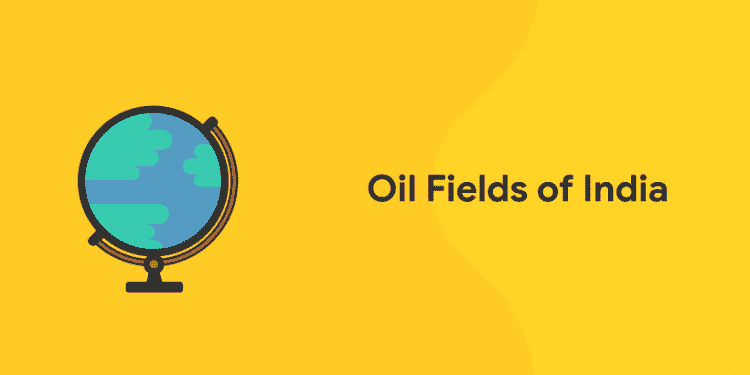Table of Contents
It was in the year 1889, near the town of Digboi in Assam, that the first oil deposits in the country were discovered. This was when the oil and gas industry in India was formed. In this era where the talk of the town is the spike and increased cost of petrol and fuel, let us have a look at from where these fuels are coming from- the oil fields of India.
With the discovery of gas fields in Gujarat and Assam, India’s natural gas industry began in the 1960s. As per the reports dated 31 March 2018, India had estimated natural gas reserves of 1339.57 billion cubic meters (BCM) and crude oil reserves of 594.49 million tonnes (MT).
List of Oil Fields in India
So what exactly is an oil field? An oil field is simply a tract of land used for the intention of extracting petroleum, such as crude oil or natural gas, from the ground. There are quite a few oil fields in India ranging from the Western offshore to the Eastern offshore. The largest oil reserves are found in the Western offshore with a 40% reserve in Mumbai High and Krishna-Godavari Basin, and 27% in Assam. The largest natural gas reserves are found in the Eastern offshore with a reserve of 38.13% in contrast to the Western Offshore which has a natural gas reserve of 23.33%.
The table below gives an outline of the oil reserves and natural gas reserves found in their respective states, as of 31st March 2017.
| State | Crude oil reserves
(in million metric tonnes) |
Natural gas reserves
(in BCM) |
| Arunachal Pradesh | 1.52 | 0.93 |
| Andhra Pradesh | 8.15 | 48.31 |
| Assam | 159.96 | 158.57 |
| Coal Bed Methane | 0 | 106.58 |
| Eastern Offshore | 40.67 | 507.76 |
| Gujarat | 118.61 | 62.28 |
| Nagaland | 2.38 | 0.09 |
| Rajasthan | 24.55 | 34.86 |
| Tamil Nadu | 9.00 | 31.98 |
| Tripura | 0.07 | 36.10 |
| Western Offshore | 239.20 | 302.35 |
| Total | 604.10 | 1,289.81 |
On-shore and Offshore Oil Fields in India
1: Who was the first woman President of India?
India has both on-shore and offshore oil fields. Onshore oil fields are located in Gujarat Coast in Western India, Brahmaputra Valley in North-East India and Cauvery onshore basin in Tamil Nadu.
The major oil field regions in India are the North East, Western Coast, Rajasthan and Gujarat. You can also check out the various oil refineries in India.
NORTH-EAST REGION
The major oilfields in North East India are the Brahmaputra valley in Assam and also its neighbouring areas including Arunachal Pradesh, Nagaland, Tripura, Manipur Meghalaya, and Mizoram.
Assam
Assam is by no doubt the country’s oldest oil-producing state and its major oil fields are:
- Digboi field
- Naharkatiya field
- Moran-Hugrijan field
- Digboi Field
Digboi is the oldest oil field in India situated in the northeast of Tipam hills in the Dibrugarh district of Upper Assam. The oil-bearing strata expanses an area of about 13 sq km where oil availability is at 400 to 2,000-metre depth.
So far, over 800 oil wells have been drilled in Digboi. Before oil fields of west India were opened, Digboi used to represent three-fourths of the total oil production of India. The most important oil centres are Digboi, Bappapang, Hassapang and Paintola. However, most oil is directed to the oil refinery at Digboi.
- Naharkatiya Field
It is located at the left bank of the Burhi Dibing river at a distance of 32 km southwest of Digboi. Oil was discovered here in 1953 and its production started in 1954. Oil is available at depths ranging from 4,000 metres to 5,000 metres. Out of the 60 successful wells drilled so far, 56 are oil-producing while the remaining 4 wells produce natural gas.
- Moran-Hugrijan field
This oil field is located about 40 km southwest of Naharkatiya. Oil was discovered at Moran- Hugrijan field in the year 1953 and they started production in 1956. Drilling has resulted in an oil-bearing Barail horizon at a depth of 3,355 metres. Moran’s potential oil capacity may be estimated at one million tonnes per annum. As many as 20 wells that yield oil, as well as gas, have been drilled here.
Other fields have been discovered at Rudrasagar, Badarpur, Sibsagar, Lakwa, Galecki,, Barholla and Anguri.
The annual production of oil is 2.5 million tonnes and one million cubic metres of natural gas. Oil from this area is directed to oil refineries at Noonamati in Assam (443 km) and Barauni in Bihar (724 km) through a pipeline.
Western Region
Gujarat
Explorations and discoveries by the Oil and Natural Gas Commission (ONGC) have given valuable findings of oil-bearing rock strata expanding an area of about 15,360 sq km around the Gulf of Khambhat in Gujarat. The major oil belt stretches from Surat to Amreli. Districts of Gujarat like Kachchh, Vadodara, Surat, Ahmedabad, Bharuch, Kheda, Mehsana, etc. are the main oil-producing districts.
In 2002-03, Gujarat yielded a production of over 60 lakh tonnes of crude oil which accounted for more than 18 per cent of the total oil production of India. Ankleshwar, Kalol, Nawgam, Lunej, Barkol, Kosamba, Kathana, Mehsana and Sanand are the major oilfields of the Western regions.
- Ankleshwar Field
With the discovery of the Ankleshwar field, the first major oil field came in 1958, located about 80 km south of Vadodara and around 160 km south of Khambhat. Ankleshwar anticline is around 20 km long and 4 km wide. Though oil is available at depths varying from 1,000 to 1,200 metres, it has a capacity of 2.8 million tonnes annually.
It is such a productive oilfield that Pandit Jawahar Lal Nehru called it the fountain of prosperity due to its abundance. So far, as many as 170 oil wells have been drilled. There is an estimation that 25 lakh tonnes per year of oil could be obtained from this particular field. Oil from this field is usually sent to refineries at Trombay and Koyali.
- Khambhat or Lunej Field
In 1958, the oil and Natural Gas Commission drilled bore wells at Lunej near Ahmadabad and confirmed the event of a commercially exploitable oil field. Oil was obtained on 4th September 1959. Up until 1969, a total of 62 wells were drilled out of which 19 wells yielded natural gas while 3 wells yielded oil. The production of oil is 15 lakh tonnes and 8-10 lakh cubic metres of gas per annum. The total estimation of reserves is at 3 crore tonnes.
- Ahmedabad and Kalol Field
This field lies about 25 km northwest of Ahmedabad. This field and a part of the Khambhat basin contain ‘pools’ of heavy crude trapped in chunks of coal. Nawgam, Sanand, Kosamba, Mehsana, Kathana, etc. are major producers.
Oil has also been discovered in Olkad, Kadi, Asjol, Dholka, Bandrat, Sobhasan, Sandkhurd, Siswas, Nandesan, and Vadesar areas.
Practice latest GK quizzes here
Rajasthan
In 2004 one of the largest inland oil discoveries was made in the Banner district of Rajasthan. The oil block expanses an area of approximately 5,000 sq km. Innovative geological modelling with state-of-the-art technology was used in discovering this oil field. Initial estimates of the amount of oil in this place of discovery range from 63 to 153 million tonnes.
Two important discoveries, Sarswati and Rajeshwari, with a total of 35 million tonnes of in-place oil reserves were made earlier in the year 2002. The Sarswati discovery yielded 14 million tonnes of in-place oil reserves for which drilling up to 3,476 metres was done.
Western Coast Region
Mumbai High
The greatest achievement by the ONGC with respect to offshore surveys for oil was that of Mumbai High in 1974. Mumbai High is located on the continental shelf off the coast of Maharashtra about 176 km northwest of Mumbai. The greatest productivity success was achieved in 1974 by the ONGC with respect to offshore oil surveys in Mumbai High.
Here the rock strata of the Miocene age surrounds an area of 2,500 sq km with estimated reserves of about 330 million tonnes of oil and 37,000 million cubic metres of natural gas. Production on a commercial scale began in 1976. Oil is basically extracted from a depth of over 1,400 metres with the aid of a specially designed platform known as Sagar Samrat.
The discovery of Mumbai High has revolutionised the production of oil in India. The share of Mumbai High has shot up noticeably in the total oil production of India. In the year 1982, this area produced 85 lakh tonnes of oil which increased to over 189 lakh tonnes or over 62 per cent in the year 1991-92.
Production from this field dropped between the year 1989-90 and 1993-94 due to overexploitation. Remedial measures have been undertaken to enhance and maximize the production and thus the declining trend has been reversed since the year 1994-95. In the year 2002-03 this area produced 215.73 lakh tonnes of oil which were actually about two-thirds of the total production of India.
Bassein
Located to the south of Mumbai High, this is a recent discovery provided with reserves that may prove to be higher than those of Mumbai High. Massive reserves have been found at a depth of 1,900 metres. Production has started and is well expected to pick up at a fast rate.
Aliabet
This oil field is located at Aliabet Island in the Gulf of Khambhat about 45 km off Bhavnagar. Massive reserves have been discovered in this field. A whopping amount of Rs 400 crore has been spent already on this field. Commercial production is anticipated to start soon.
East Coast Region
The delta and Basin regions of the Godawari, the Cauvery and the Krishna rivers hold great capacity for the production of oil and gas. As a result, these are both on-shore and off-shore regions where extensive exploration has been conducted during the past few years. The Rawa field located in Krishna- Godawari off-shore basin is expected to produce 1 to 3 million tonnes of crude oil every year.
Tamil Nadu produced 3.95 lakh tonnes of oil in the year 2002-03 which were slightly more than one per cent of India’s total oil production. The Narimanam and Kovilappal oilfields in the on-shore basin of Cauvery are anticipated to produce about 4 lakh tonnes of crude oil annually. A refinery holding a capacity of 5 lakh tonne is being set up at Panaigudi near Chennai to refine crude oil from this area.
Andhra Pradesh produces less than 1% of the total crude oil of India. Recently, oilfields have been discovered in the Krishna-Godavari basin. The oilfield near Amolpur is expected to give 3,600 barrels of crude oil per day.
Hope you found this article on the oil fields of India beneficial and resourceful. Do check out our page for more interesting blogs. Entri wishes its readers a wonderful day!













